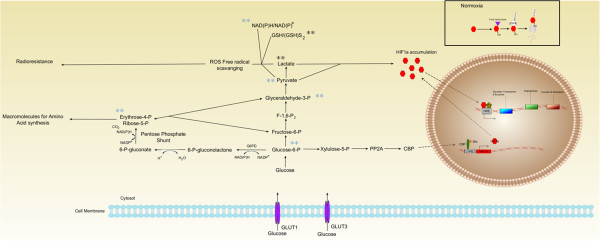Figure 2.

The interplay of the tumor microenvironment on radioresistance and glucose metabolism. Under normoxic conditions (insert) HIF1α is targeted for degradation. The ODD domain is hydroxylated and ubiquinated by prolyl hydroxylases (purple triangle) and pVHL-containing E3 ubiquitin ligases (circle). However, under hypoxic conditions HIF1α is stabilized and activated by binding to HIF1β and the resulting dimer binds to the HRE inducing the expression of genes leading to angiogenesis, such as VEGF and SDF1, invasion, metastasis, and glycolytic transporters and enzymes (GLUT1). Furthermore, the cells use of the inefficient ATP producing glycolytic pathway may affect hypoxic and normoxic radioresistance. Key intermediaries of the glycolytic pathway, glucose-6-phosphate, pyruvate, lactate, and the reducing couples NAD(P)H/NAD(P)+ and GSH/GSH-disulfide, have been observed to play roles in continuing the cycle of maintaining HIF1α. Glucose-6-phosphate can either enter into the pentose phosphate pathway leading to the synthesis of erythrose-4-phosphate and ribose-5-phosphate which are necessary for amino acid synthesis or can feed back into glycolysis and create lactate and pyruvate, which lead to HIF1α accumulation continuing the cycle of transcription. Alternatively, glucose-6-phosphate can also lead to the transcription of HIF1α by entering into the pathway which ultimately leads to the nuclear translocation of CREB-binding protein (CBP) which binds with Mlx leading to HIF1α transcription. Lactate and pyruvate along with the reducing couples scavenge reactive oxygen species (ROS) free radicals which can also lead to radioresistance. It is still unclear whether radiosensitizing drugs are necessary for carbon ions; however some experiments have shown that targeting specific crucial players of the glycolytic pathway in combination with carbon ions leaded to enhanced cell kill. It may warrant targeting other important intermediaries (i.e. glucose-6-phosphate) with carbon ions to possibly enhance treatments. Black asterisks represent experimentally determined radiosensitization; blue asterisks represent hypothesized radiosensitization targets.
